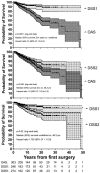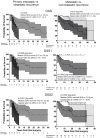Metastatic disease and major adverse cardiovascular events preceding diagnosis are the main determinants of disease-specific survival of pheochromocytoma/paraganglioma: long-term follow-up of 303 patients
- PMID: 39234504
- PMCID: PMC11371702
- DOI: 10.3389/fendo.2024.1419028
Metastatic disease and major adverse cardiovascular events preceding diagnosis are the main determinants of disease-specific survival of pheochromocytoma/paraganglioma: long-term follow-up of 303 patients
Abstract
Purpose: The natural history in unselected cohorts of patients with pheochromocytoma/ paraganglioma (PPGL) followed for a period >10 years remains limited. We aimed to describe baseline characteristics and outcome of a large cohort and to identify predictors of shorter survival.
Methods: This retrospective single-center study included 303 patients with newly diagnosed PPGL from 1968 to December 31, 2023, in 199 prospectively supplemented since July 2020. Mean follow-up was 11.4 (range 0.3-50) years, germline genetic analyses were available in 92.1%. The main outcome measures were overall (OAS), disease-specific (DSS), recurrence-free (RFS) survival and predictors of shorter survival evaluated in patients with metastases at first diagnosis (n=12), metastatic (n=24) and nonmetastatic (n=33) recurrences and without evidence of PPGL after first surgery (n=234).
Results: Age at study begin was 49.4 ± 16.3 years. There were 72 (23.8%) deaths, 15 (5.0%), 29 (9.6%) and 28 (9.2%) due to PPGL, cardiovascular disease (CVD) and malignant or other diseases, respectively. Median OAS, DSS1 (tumor-related) and DSS2 (DSS1 and death caused by CVD) were 4.8, 5.9 and 5.2 years (patients with metastases at first diagnosis), 21.2, 21.2 and 19.9 years, and 38.0, undefined and 38.0 years (patients with metastatic and with nonmetastatic recurrences, respectively). Major adverse cardiovascular events (MACE) preceded the first diagnosis in 15% (n=44). Shorter DSS2 correlated with older age (P ≤ 0.001), male sex (P ≤ 0.02), MACE (P ≤ 0.01) and primary metastases (P<0.0001, also for DSS1).
Conclusion: The clinical course of unselected patients with PPGL is rather benign. Survival rates remain high for decades, unless there are MACE before diagnosis or metastatic disease.
Keywords: genetics; long-term follow-up; natural history; paraganglioma; pheochromocytoma; recurrence; survival.
Copyright © 2024 Raber, Schendl, Arikan, Scheuba, Mazal, Stadlmann, Lehner, Zeitlhofer, Baumgartner-Parzer, Gabler and Esterbauer.
Conflict of interest statement
The authors declare that the research was conducted in the absence of any commercial or financial relationships that could be construed as a potential conflict of interest.
Figures




Similar articles
-
Locally advanced pheochromocytoma/paraganglioma exhibit high metastatic recurrence and disease specific mortality rates: long-term follow-up of 283 patients.Eur J Endocrinol. 2025 May 30;192(6):705-716. doi: 10.1093/ejendo/lvaf104. Eur J Endocrinol. 2025. PMID: 40393073
-
Malignant Pheochromocytoma and Paraganglioma: 272 Patients Over 55 Years.J Clin Endocrinol Metab. 2017 Sep 1;102(9):3296-3305. doi: 10.1210/jc.2017-00992. J Clin Endocrinol Metab. 2017. PMID: 28605453 Free PMC article.
-
Predicting Metastatic Potential in Pheochromocytoma and Paraganglioma: A Comparison of PASS and GAPP Scoring Systems.J Clin Endocrinol Metab. 2020 Dec 1;105(12):e4661-70. doi: 10.1210/clinem/dgaa608. J Clin Endocrinol Metab. 2020. PMID: 32877928 Free PMC article.
-
Metastatic pheochromocytoma and paraganglioma: recent advances in prognosis and management.Curr Opin Endocrinol Diabetes Obes. 2019 Jun;26(3):146-154. doi: 10.1097/MED.0000000000000476. Curr Opin Endocrinol Diabetes Obes. 2019. PMID: 30893083 Review.
-
TAKOTSUBO-LIKE CARDIOMYOPATHY IN A LARGE COHORT OF PATIENTS WITH PHEOCHROMOCYTOMA AND PARAGANGLIOMA.Endocr Pract. 2017 Oct;23(10):1178-1192. doi: 10.4158/EP171930.OR. Epub 2017 Jul 13. Endocr Pract. 2017. PMID: 28704094 Review.
Cited by
-
Sex differences in management and outcomes in pheochromocytomas and paragangliomas.Front Endocrinol (Lausanne). 2025 Jun 16;16:1597908. doi: 10.3389/fendo.2025.1597908. eCollection 2025. Front Endocrinol (Lausanne). 2025. PMID: 40589516 Free PMC article.
-
Molecular radiotherapy for adult type metastatic neuroendocrine tumours in children.Eur J Nucl Med Mol Imaging. 2025 Apr 24. doi: 10.1007/s00259-025-07247-6. Online ahead of print. Eur J Nucl Med Mol Imaging. 2025. PMID: 40272497
-
Functional paraganglioma of the pancreatic head: A case report and review of literature.World J Gastrointest Surg. 2025 Jul 27;17(7):105833. doi: 10.4240/wjgs.v17.i7.105833. World J Gastrointest Surg. 2025. PMID: 40740935 Free PMC article.
References
-
- Berends AMA, Buitenwerf E, de Krijger RR, Veeger NJGM, van der Horst-Schrivers ANA, Links TP, et al. . Incidence of pheochromocytoma and sympathetic paraganglioma in the Netherlands: A nationwide study and systematic review. Eur J Intern Med. (2018) 51:68–73. doi: 10.1016/j.ejim.2018.01.015 - DOI - PubMed
MeSH terms
LinkOut - more resources
Full Text Sources
Medical

